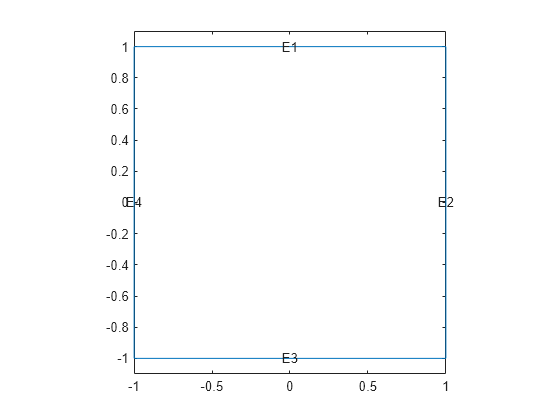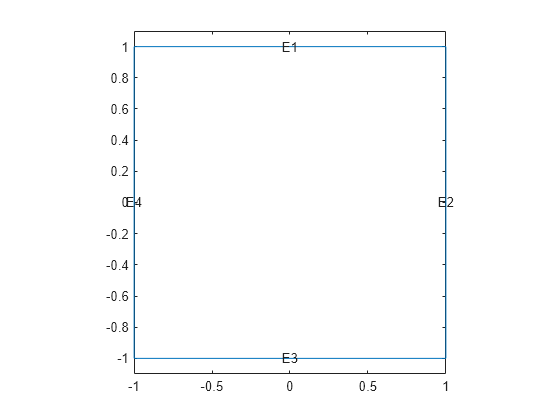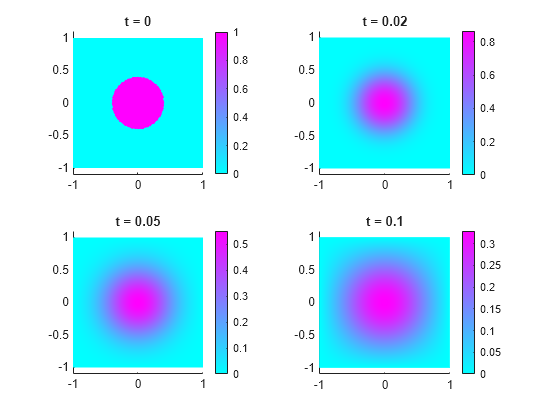parabolic
(Not recommended) Solve parabolic PDE problem
parabolic is not recommended. Use solvepde instead.
Syntax
Description
Parabolic equation solver
Solves PDE problems of the type
on a 2-D or 3-D region Ω, or the system PDE problem
The variables c, a, f, and d can depend on position, time, and the solution u and its gradient.
u = parabolic(u0,tlist,model,c,a,f,d)
on a 2-D or 3-D region Ω, or the system PDE problem
with geometry, mesh, and boundary conditions specified in model, and
with initial value u0. The variables c,
a, f, and d in the equation
correspond to the function coefficients c, a,
f, and d respectively.
u = parabolic(___,'Stats','off')
Examples
Solve the parabolic equation
on the square domain specified by squareg.
Create a PDE model and import the geometry.
model = createpde; geometryFromEdges(model,@squareg); pdegplot(model,'EdgeLabels','on') ylim([-1.1,1.1]) axis equal

Set Dirichlet boundary conditions on all edges.
applyBoundaryCondition(model,'dirichlet',... 'Edge',1:model.Geometry.NumEdges, ... 'u',0);
Generate a relatively fine mesh.
generateMesh(model,'Hmax',0.02,'GeometricOrder','linear');
Set the initial condition to have on the disk and elsewhere.
p = model.Mesh.Nodes; u0 = zeros(size(p,2),1); ix = find(sqrt(p(1,:).^2 + p(2,:).^2) <= 0.4); u0(ix) = ones(size(ix));
Set solution times to be from 0 to 0.1 with step size 0.005.
tlist = linspace(0,0.1,21);
Create the PDE coefficients.
c = 1; a = 0; f = 0; d = 1;
Solve the PDE.
u = parabolic(u0,tlist,model,c,a,f,d);
134 successful steps 0 failed attempts 270 function evaluations 1 partial derivatives 26 LU decompositions 269 solutions of linear systems
Plot the initial condition, the solution at the final time, and two intermediate solutions.
figure subplot(2,2,1) pdeplot(model,'XYData',u(:,1)); axis equal title('t = 0') subplot(2,2,2) pdeplot(model,'XYData',u(:,5)) axis equal title('t = 0.02') subplot(2,2,3) pdeplot(model,'XYData',u(:,11)) axis equal title('t = 0.05') subplot(2,2,4) pdeplot(model,'XYData',u(:,end)) axis equal title('t = 0.1')

Solve the parabolic equation
on the square domain specified by squareg, using a geometry function to specify the geometry, a boundary function to specify the boundary conditions, and using initmesh to create the finite element mesh.
Specify the geometry as @squareg and plot the geometry.
g = @squareg; pdegplot(g,'EdgeLabels','on') ylim([-1.1,1.1]) axis equal

Set Dirichlet boundary conditions on all edges. The squareb1 function specifies these boundary conditions.
b = @squareb1;
Generate a relatively fine mesh.
[p,e,t] = initmesh(g,'Hmax',0.02);Set the initial condition to have on the disk and elsewhere.
u0 = zeros(size(p,2),1); ix = find(sqrt(p(1,:).^2 + p(2,:).^2) <= 0.4); u0(ix) = ones(size(ix));
Set solution times to be from 0 to 0.1 with step size 0.005.
tlist = linspace(0,0.1,21);
Create the PDE coefficients.
c = 1; a = 0; f = 0; d = 1;
Solve the PDE.
u = parabolic(u0,tlist,b,p,e,t,c,a,f,d);
147 successful steps 0 failed attempts 296 function evaluations 1 partial derivatives 28 LU decompositions 295 solutions of linear systems
Plot the initial condition, the solution at the final time, and two intermediate solutions.
figure subplot(2,2,1) pdeplot(p,e,t,'XYData',u(:,1)); axis equal title('t = 0') subplot(2,2,2) pdeplot(p,e,t,'XYData',u(:,5)) axis equal title('t = 0.02') subplot(2,2,3) pdeplot(p,e,t,'XYData',u(:,11)) axis equal title('t = 0.05') subplot(2,2,4) pdeplot(p,e,t,'XYData',u(:,end)) axis equal title('t = 0.1')

Create finite element matrices that encode a parabolic problem, and solve the problem.
The problem is the evolution of temperature in a conducting block. The block is a rectangular slab.
model = createpde(1); importGeometry(model,'Block.stl'); handl = pdegplot(model,'FaceLabels','on'); view(-42,24) handl(1).FaceAlpha = 0.5;

Faces 1, 4, and 6 of the slab are kept at 0 degrees. The other faces are insulated. Include the boundary condition on faces 1, 4, and 6. You do not need to include the boundary condition on the other faces because the default condition is insulated.
applyBoundaryCondition(model,'dirichlet','Face',[1,4,6],'u',0);
The initial temperature distribution in the block has the form
generateMesh(model); p = model.Mesh.Nodes; x = p(1,:); y = p(2,:); z = p(3,:); u0 = x.*y.*z*1e-3;
The parabolic equation in toolbox syntax is
Suppose the thermal conductivity of the block leads to a coefficient value of 1. The values of the other coefficients in this problem are , , and .
d = 1; c = 1; a = 0; f = 0;
Create the finite element matrices that encode the problem.
[Kc,Fc,B,ud] = assempde(model,c,a,f); [~,M,~] = assema(model,0,d,f);
Solve the problem at time steps of 1 for times ranging from 0 to 40.
tlist = linspace(0,40,41); u = parabolic(u0,tlist,Kc,Fc,B,ud,M);
35 successful steps 0 failed attempts 72 function evaluations 1 partial derivatives 11 LU decompositions 71 solutions of linear systems
Plot the solution on the outside of the block at times 0, 10, 25, and 40. Ensure that the coloring is the same for all plots.
umin = min(min(u)); umax = max(max(u)); subplot(2,2,1) pdeplot3D(model,'ColorMapData',u(:,1)) colorbar off view(125,22) title 't = 0' clim([umin umax]); subplot(2,2,2) pdeplot3D(model,'ColorMapData',u(:,11)) colorbar off view(125,22) title 't = 10' clim([umin umax]); subplot(2,2,3) pdeplot3D(model,'ColorMapData',u(:,26)) colorbar off view(125,22) title 't = 25' clim([umin umax]); subplot(2,2,4) pdeplot3D(model,'ColorMapData',u(:,41)) colorbar off view(125,22) title 't = 40' clim([umin umax]);

Input Arguments
Initial condition, specified as a scalar, vector of nodal values, character vector, character
array, string scalar, or string vector. The initial condition is the value of the
solution u at the initial time, specified as a column vector of
values at the nodes. The nodes are either p in the
[p,e,t] data structure, or are
model.Mesh.Nodes.
If the initial condition is a constant scalar
v, specifyu0asv.If there are
Npnodes in the mesh, and N equations in the system of PDEs, specifyu0as a column vector ofNp*N elements, where the firstNpelements correspond to the first component of the solutionu, the secondNpelements correspond to the second component of the solutionu, etc.Give a text expression of a function, such as
'x.^2 + 5*cos(x.*y)'. If you have a system of N > 1 equations, give a text array such aschar('x.^2 + 5*cos(x.*y)',... 'tanh(x.*y)./(1+z.^2)')
Example: x.^2+5*cos(y.*x)
Data Types: double | char | string
Complex Number Support: Yes
Solution times, specified as a real vector. The solver returns the solution to the PDE at the solution times.
Example: 0:0.2:4
Data Types: double
PDE model, specified as a PDEModel object.
Example: model = createpde
PDE coefficient, specified as a scalar, matrix, character vector, character array,
string scalar, string vector, or coefficient function. c represents
the c coefficient in the scalar PDE
or in the system of PDEs
Example: 'cosh(x+y.^2)'
Data Types: double | char | string | function_handle
Complex Number Support: Yes
PDE coefficient, specified as a scalar, matrix, character vector, character array,
string scalar, string vector, or coefficient function. a represents
the a coefficient in the scalar PDE
or in the system of PDEs
Example: 2*eye(3)
Data Types: double | char | string | function_handle
Complex Number Support: Yes
PDE coefficient, specified as a scalar, matrix, character vector, character array,
string scalar, string vector, or coefficient function. f represents
the f coefficient in the scalar PDE
or in the system of PDEs
Example: char('sin(x)';'cos(y)';'tan(z)')
Data Types: double | char | string | function_handle
Complex Number Support: Yes
PDE coefficient, specified as a scalar, matrix, character vector, character array,
string scalar, string vector, or coefficient function. d represents
the d coefficient in the scalar PDE
or in the system of PDEs
Example: 2*eye(3)
Data Types: double | char | string | function_handle
Complex Number Support: Yes
Boundary conditions, specified as a boundary matrix or boundary file. Pass a boundary file as a function handle or as a file name. A boundary matrix is generally an export from the PDE Modeler app.
Example: b = 'circleb1', b = "circleb1", or b =
@circleb1
Data Types: double | char | string | function_handle
Mesh points, specified as a 2-by-Np matrix of points, where
Np is the number of points in the mesh. For a description of the
(p,e,t) matrices, see Mesh Data as [p,e,t] Triples.
Typically, you use the p, e, and t
data exported from the PDE Modeler app, or generated by initmesh or refinemesh.
Example: [p,e,t] = initmesh(gd)
Data Types: double
Mesh edges, specified as a 7-by-Ne matrix of edges,
where Ne is the number of edges in the mesh. For a description of the
(p,e,t) matrices, see Mesh Data as [p,e,t] Triples.
Typically, you use the p, e, and t
data exported from the PDE Modeler app, or generated by initmesh or refinemesh.
Example: [p,e,t] = initmesh(gd)
Data Types: double
Mesh triangles, specified as a 4-by-Nt matrix of
triangles, where Nt is the number of triangles in the mesh. For a
description of the (p,e,t)
matrices, see Mesh Data as [p,e,t] Triples.
Typically, you use the p, e, and t
data exported from the PDE Modeler app, or generated by initmesh or refinemesh.
Example: [p,e,t] = initmesh(gd)
Data Types: double
Stiffness matrix, specified as a sparse matrix or as a full
matrix. See Elliptic Equations. Typically, Kc is
the output of assempde.
Load vector, specified as a vector. See Elliptic Equations. Typically, Fc is the
output of assempde.
Dirichlet nullspace, returned as a sparse matrix. See Algorithms. Typically, B is
the output of assempde.
Dirichlet vector, returned as a vector. See Algorithms. Typically, ud is
the output of assempde.
Mass matrix. specified as a sparse matrix or a full matrix. See Elliptic Equations.
To obtain the input matrices for pdeeig, hyperbolic or parabolic,
run both assema and assempde:
[Kc,Fc,B,ud] = assempde(model,c,a,f); [~,M,~] = assema(model,0,d,f);
Note
Create the M matrix using assema with d,
not a, as the argument before f.
Data Types: double
Complex Number Support: Yes
Relative tolerance for ODE solver, specified as a positive real.
Example: 2e-4
Data Types: double
Absolute tolerance for ODE solver, specified as a positive real.
Example: 2e-7
Data Types: double
Output Arguments
PDE solution, returned as a matrix. The matrix is Np*N-by-T,
where Np is the number of nodes in the mesh, N is
the number of equations in the PDE (N = 1 for a
scalar PDE), and T is the number of solution times,
meaning the length of tlist. The solution matrix
has the following structure.
The first
Npelements of each column inurepresent the solution of equation 1, then nextNpelements represent the solution of equation 2, etc. The solutionuis the value at the corresponding node in the mesh.Column
iofurepresents the solution at timetlist(i).
To obtain the solution at an arbitrary point in the geometry,
use pdeInterpolant.
Algorithms
parabolic internally calls assema,
assemb, and assempde to create finite element
matrices corresponding to the problem. It calls ode15s to solve the resulting system of ordinary differential
equations.
Partial Differential Equation Toolbox™ solves equations of the form
When the m coefficient is 0, but d is not, the documentation refers to the equation as parabolic, whether or not it is mathematically in parabolic form.
A parabolic problem is to solve the equation
with the initial condition
u(x,0) = u0(x) for x∊Ω
where x represents a 2-D or 3-D point and there are boundary conditions of the same kind as for the elliptic equation on ∂Ω.
The heat equation reads
in the presence of distributed heat loss to the surroundings. ρ is the density, C is the thermal capacity, k is the thermal conductivity, h is the film coefficient, u∞ is the ambient temperature, and f is the heat source.
For time-independent coefficients, the steady-state solution of the equation is the solution to the standard elliptic equation
–∇ · (c∇u) + au = f.
Assuming a mesh on Ω and t ≥ 0, expand the solution to the PDE (as a function of x) in the Finite Element Method basis:
Plugging the expansion into the PDE, multiplying with a test function ϕj, integrating over Ω, and applying Green's formula and the boundary conditions yield
In matrix notation, we have to solve the linear, large and sparse ODE system
This method is traditionally called method of lines semidiscretization.
Solving the ODE with the initial value
Ui(0) = u0(xi)
yields the solution to the PDE at each node xi and time t. Note that K and F are the stiffness matrix and the right-hand side of the elliptic problem
–∇ · (c∇u) + au = f in Ω
with the original boundary conditions, while M is just the mass matrix of the problem
–∇ · (0∇u) + du = 0 in Ω.
When the Dirichlet conditions are time dependent, F contains contributions from time derivatives of h and r. These derivatives are evaluated by finite differences of the user-specified data.
The ODE system is ill conditioned. Explicit time integrators are forced by stability
requirements to very short time steps while implicit solvers can be expensive since they
solve an elliptic problem at every time step. The numerical integration of the ODE system is
performed by the MATLAB® ODE Suite functions, which are efficient for this class of problems. The time
step is controlled to satisfy a tolerance on the error, and factorizations of coefficient
matrices are performed only when necessary. When coefficients are time dependent, the
necessity of reevaluating and refactorizing the matrices each time step may still make the
solution time consuming, although parabolic reevaluates only that which
varies with time. In certain cases a time-dependent Dirichlet matrix h(t) may cause the error control to fail, even if the
problem is mathematically sound and the solution u(t)
is smooth. This can happen because the ODE integrator looks only at the reduced solution
v with u = Bv +
ud. As h changes, the pivoting scheme
employed for numerical stability may change the elimination order from one step to the next.
This means that B, v, and ud all
change discontinuously, although u itself does not.
Version History
Introduced before R2006aparabolic is not recommended. Use solvepde instead. There are no plans to remove
parabolic.
You can now solve parabolic equations whose coefficients depend on the solution u or on the gradient of u.
See Also
MATLAB Command
You clicked a link that corresponds to this MATLAB command:
Run the command by entering it in the MATLAB Command Window. Web browsers do not support MATLAB commands.
웹사이트 선택
번역된 콘텐츠를 보고 지역별 이벤트와 혜택을 살펴보려면 웹사이트를 선택하십시오. 현재 계신 지역에 따라 다음 웹사이트를 권장합니다:
또한 다음 목록에서 웹사이트를 선택하실 수도 있습니다.
사이트 성능 최적화 방법
최고의 사이트 성능을 위해 중국 사이트(중국어 또는 영어)를 선택하십시오. 현재 계신 지역에서는 다른 국가의 MathWorks 사이트 방문이 최적화되지 않았습니다.
미주
- América Latina (Español)
- Canada (English)
- United States (English)
유럽
- Belgium (English)
- Denmark (English)
- Deutschland (Deutsch)
- España (Español)
- Finland (English)
- France (Français)
- Ireland (English)
- Italia (Italiano)
- Luxembourg (English)
- Netherlands (English)
- Norway (English)
- Österreich (Deutsch)
- Portugal (English)
- Sweden (English)
- Switzerland
- United Kingdom (English)